|
Luiz
Filipe Varella was born in Porto Alegre city, state of Rio Grande
do Sul, is a lawyer, graduated by the PUC/RS. Two reasons were fundamental
for making him an orchid lover: le photo and his passion for the
Atlantic Forest existing in his hometown. First he fell in love
for the bromeliads he found along side the BR 101 road and orchids
come almost by chance when he kicked, involuntarily, a small branch
with a clump of Capanemia superflua with an inflorescence
about to open.
|
|
|
ON:
Why did you start to cultivate orchids? Which was the magic moment
of attraction?
LF: In fact, before the orchids, there were the bromeliads I used
to see in Florianópolis. By this time, I started to notice
the quantity of bromeliads in the trees alongside the road, mainly
Vriesea and Aechmea, then I noticed the quantity
of Tillandsia we could found in just a one branch, sometimes
(T.gardneri, T.geminiflora. T.stricta, T.aeranthos. T.mallemontii...).
This got my attention and I started observing and to taking notes
of the differences between the species, blooming season as well
as the different colors and form varieties.
|
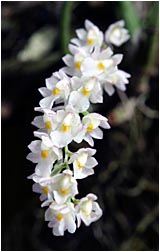
Capanemia superflua |
In excursion
through the Rio Grande do Sul mountains, I I noticed that although
there were also many bromeliads, the species were not the same because
the climate is completely different.
I started to photo orchids, spending films and films (the digital
camera came later) and try to identify the plants. Then I discovered
that in internet there is a good material for this. Soon I noticed
that there were much more besides the bromeliads in all those trees,
there were a lot of orchids mainly micro-orchids.
Capanemia superflua was the first that really fascinated
me; in a walk along the road in Canela, in the mountain, I kicked,
involuntarily, a small branch with a clump of Capanemia superflua
with an inflorescence about to open.
I always have this plant, my first micro-orchid.
|
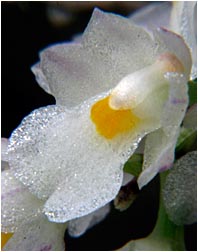
Capanemia superflua |
|
ON
- Besides
this, was there another influence (person or fact) ?
LF - There were two fundamental reasons: the photography and the
passion for the places where there are really a lot of orchids.–
The Atlantic Forest, in the slopes of Geral Mountains, in the northeast
of the state of Rio Grande do Sul and southeast of the state of
Santa Catarina, in the top of the mountains of Rio Grande Sul and
Santa Catarina, the primitive woods are still there. Gathering those
three elements - photo, mountains and wood - I have been definitively
seduced. How wonderful is to photograph a blooming plant in the
habitat. I have an increasing list of species that I have seen in
the nature. All along those years and due to the search of more
information and novelties, I got friendship that brings me knowledge,
happiness and new experiences. The participation in the group of
discussion about orchids and bromeliads in and the personal contact
with a lot of people are really important. As well as the meeting
with the Orchid society from Rio Grande do Sul, where I have been
attending since 2006.
Contributing with photos to the sites like the one by Jay Pfahl
and help with plants to the Orchidstudium Project are also really
a reward.
There is another interesting thing, the attempt to identify species.
I become almost crazy trying to do this or comparing varieties.
One of those doubts came some months ago trying to identify a Rhinocidium
(Oncidium) – would be a R.macronyx or a R.longicornu?
I was sleepless until to be sure that it was a Rhinocidium macronyx.
In the toil of those battles, I visit sites, consult books as a
fool and send e-mail to the group of discussion. And it is good
when the identification finally comes. How good is to get a tag
and to write the name of the small plant (even though , sometimes,
still in doubt, I put a question mark. It happens, for example,
with most part of Octomerias and Stelis)..
ON: How
long have you been cultivating orchids?
LF: Eight years since my first Capanemia superflua.
|
|
ON:
How
many plants do you have?
LF: It is hard to say. The only thing I can say is that I don't
have all I want to have. May by, there are 110, 120 genus, distributed
among 300 different species. I have everything annotated but it
is a "floating" control due to the enormous quantity of
variety, synonyms and non identified plants.
If we consider Pleurothallis and Oncidium as unique
genera, without the new genera derived from them, those two would
be the genera with more species in my collection. I also have a
lot of Maxillaria.
|
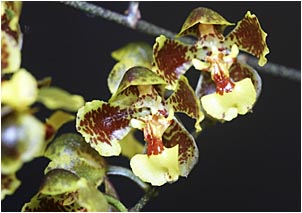 Baptistonia (Oncidium) fimbriata
Baptistonia (Oncidium) fimbriata |
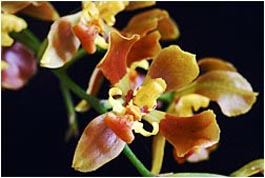 Baptistonia (Oncidium) riograndense
Baptistonia (Oncidium) riograndense |
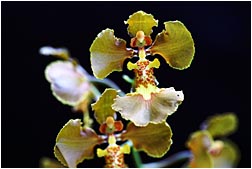 Brasilidium (Oncidium) enderianum
Brasilidium (Oncidium) enderianum |
|
ON:
How
long do you spend taking care of your orchids daily?
LF: We should calculate the real time and the virtual time. The
real time is the one I effectively spend dealing with the plants
or taking photos. It takes, at least, a hour in the morning and
more one hour (may by a hour and half) distributed along the day.
During the summer time it is better because the day starts earl
and ends later.
The virtual time is the one I spend in the internet, reading e-mails
and books, seeing photos of the plants. It is hard to calculate
how long I stay in those activities.
ON: You prefer micro-orchids. Why?
LF: First of all because they always are the plants I most find
in the nature. Every place I go, they are always there even inside
Porto Alegre city it is still possible to find Pleurothallis,
Octomerias and Oncidium. Besides, I love to photograph
and even more, I love macro-photo and the micro-orchids are a big
deal for this.
Myoxanthus or Stelis's flowers, for example, only
can be entirely seen if we do a macro photograph.Capanemia gehrti
or Barbrodria miersii's flowers can hardly be seen with the
naked eye and need a tool like macro photograph. I should also consider
that, at this moment, I do not have too much room, I cultivate my
plants at home and there is no way to cultivate big plants without
sacrificing my family's room. I intend to move plants to a better
and bigger room but for the present it is not possible.
|
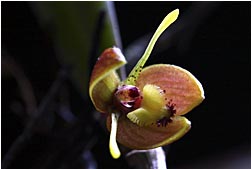
Myoxanthus lanchophyllus |
|
ON:
Among
your plants, do you have a favorite one?
LF: If I should to choose a genus, it would be Oncidium,
in special those from Rio Grande do Sul and Santa Catarina. With
all those new genera to shelter Oncidium, I opt to point
out the “small cigars”, nowadays gathered inside the
genus Baptistonia. But may be my favorites plants are Capanemia
superflua, because it was the first I collected and Ornithophora
radicans, another one that I have been seen in the nature and
which first specimen I rescued from the certain death provoked by
fungus and since then has been paying me with a very quick growing
and assured blooming in summer.
|
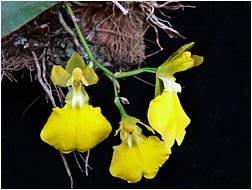 Carenidium concolor var ottonis
Carenidium concolor var ottonis
(Oncidium ottonis) |
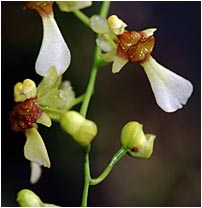 Carenidium (Oncidium) hookeri
Carenidium (Oncidium) hookeri |
|
ON:
Which are the climate conditions in your place?
LF: It is Porto Alegre climate with its known characteristics.
This winter, for example, is rainy and cold and there were many
very dry summers. If some plants like it, others suffer a lot. On
the other hand, when one says that in Porto Alegre, sometimes, you
can have all seasons in the same day, it is true! It happens a lot
in May or September, when the mornings are cold and during the day,
the temperature raises a lot and drops again at night. Thus, we
should take really care with the water and the sun. We also have
many misty days, very high environmental humidity and for some species
it is very good. In spite of all this, very often, I move the very
delicate plants, during the day depending on the evolution of the
climate.
|
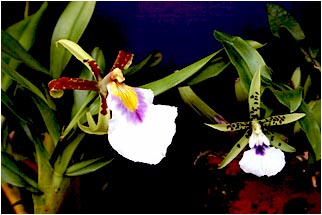 Aspasia silvana e Aspasia
lunata
Aspasia silvana e Aspasia
lunata |
ON:
What could tell us about your cultivation, the kind of substrate,
kind of pot, watering and fertilization, luminosity? Do
you have a cultivation tip to share with us?
LF: Substrate and watering vary according to the plant, to the luminosity
and even to the pot. All thing I learnt by observing the plants
themselves. Observing them is very important. Observation and patience.
I lost many plants for mistake or for trying to hasten the cultivation
but each mistake taught me something. And the rules come from this
apprenticeship. One of them that I consider, may be the most important:
Observing the plant in its habitat and trying to reproduce it in
some way.
Another rules we go on learning: clay pot retains less humidity,
plastic pot, more. Gathering too much plants makes easy the presence
of fungus, the plants needs air and ventilation. Environmental humidity
does not mean soaked substrate. Be careful since the first sign
of slugs because when you see them the damage is already big. Plants
like Sophronitis, Dracula and Masdevallia need
conditions close to those they have in the habitat. Ludisia discolor
needs less luminosity then the other plants. Maxillaria,
many of them thrive well without care. The species of Capanemia
and Ionopsis are delicate. Pleurothallis, Stelis,
Dryadella and Octomeria, except for some exceptions,
are cultivated with humidity and a very little sunlight. Brassia
does not tolerate coolness, Cymbidium loves it. Many Oncidium
do not go well in pots. Epidendrum and Encyclia
tolerate direct sunbeam.Brassavola, Dendrobium, Phaius
and Arundina, too. A Stanhopea should be potted in
order to allow the inflorescence grown down as well comes from the
bottom of the substrate. Rodriguezia decora or Renanthera
will look for room to climb.
Brief, each plant is one plant.
Substrates I tried many, sometimes successfully, sometimes, a disaster.
Some substrates are well for some plants and for another, they are
not. Pine tree "heart", for example, is good to Oncidium
flexuosum, Oncidium bifolium and Dendrobium nobile, but awful
for Cattleya intermedia. Slices of coconut are very good
however they should be small for thin roots.
|
Regarding
the organization of the plants, as I do not have a large
room in my place, I use iron shelves ranged in the walls
which do not receive direct sunlight for long time and where
the plants are not damaged by the wind. As we know, for
the most part of micro-orchids, strong sunlight and wind
are really not interesting. As I live in a hill, I face
both things. So I choose the best places and use those shelves
and use a special cloth to protect them in order to filter
only the sunbeam during the most prejudicial hours.
The most part of the micro-orchids are not big plants so
there is no danger to have conflict between the different
shelves; If an Epidendrum, for example, grows a
lot and becomes too big, I move it.
Besides,
it is possible to adapt properly those
plants with pendent inflorescence (Gomesas,
for example), I place it in an appropriate
places with those with racemes inflorescences
(as many Oncidium) and
can also hang in the same shelves those
orchids which are place in
pine
|
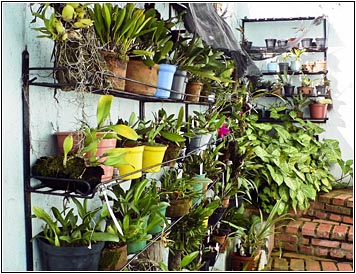 |
tree "heart',
tree fern supports or logs and different branches).Of
course, it is a repetitive exercise of observation,
move-move and accommodation, however is there
something better than to touch the small
plants? Sometimes I see myself speaking alone
with my plants.
|
ON:
One said that orchidophilia a soft manifestation of madness. Have you done any
"orchidophilic" insanity?
LF:I don't have any "orchidophilic"
insanity to tell and I don't know if one day I will have
because I have children and we should have a certain good sense.
However, I have been walking a lot looking for plants and taking
photos, soon or later, I will have a story to tell. I have already
spent a little more with a book or plants and I think it should
be considered as a little madness, nothing immoderate. An interesting
thing I have been done is to look on Google Earth small roads in
the region and going there looking for new places but it is difficult
to do the same way delineated in the computer and I become lost,
sometime. It happened twice last summer... Of course I have already
fallen from trees and rocks, I hardy failed to lose my camera trying
to photo an Ornithophora radicans. Without to tell about
almost bogging my car in the mud. But may by the biggest madness
is the idea about a project involving book, CD and site with orchids
from Rio Grande do Sul. This a planned madness.
If someone want
to know my orchids, go to http://fotos.terra.com.br/album.cgi/*mineralist
ON: Thank you very much, Luiz Filipe.
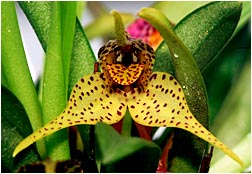
Dryadela edwalli |
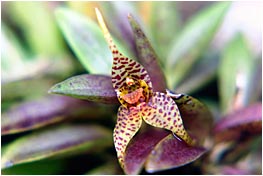
Dryadella zebrina |
Photos: Luiz Filipe
|
Any
kind of reproduction (print, digital or anyone)
of any type of material of this site: texts,
layout, photos, images and others - is
strictly forbidden without previous written permission
of the authors. Any solicitation or information
by the e-mail: bo@sergioaraujo.com
|
|